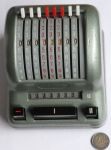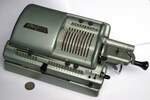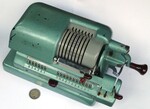



The Triumphator KA
Video
The Triumphator CRN2
Video
The Triumphator KN
History
Models
Manuals
Promotional material
Articles and advertisements
Patents
Links
The Triumphator KA is the successor to the Lipsia Addi 7. KA stands for Klein Addierer (small adder). It has an 8-digit register,with 8 input levers. It functions in much the same way as the Addi7. When you set the levers to a particular number, that register is immediately updated. You can then reset the input by pressing the large button marked I, after which the next number can be entered and added to the register. The button marked II will clear the register.
It can also subtract. To do this hold down the minus button while setting the input to the number you want to subtract. This will not yet affect the register. Release the minus button and manually set all the input levers back to zero. This subtracts the number from the register.
The levers should be moved individually. If you move several levers simultaneously, a carry operation may get lost so that the wrong answer is computed.
I own two of these machines. The first one shown below has serial number 013930. The serial number can be found stamped into the bottom of the base.
The upper casing is plastic with a metallic coating, but the base is metal. The mechanism is identical to the Lipsia Addi 7, except for a minor change to the clearing mechanism. A push of the clearing button is converted by a rack and pinion into a full rotation of the clearing axle.
Here is my other machine. It has a slightly different colour scheme, with metallic grey case and the slotted plate between the levers is light grey instead of dark green.
Its serial number is 015615. I think that no more than about 17000 were made, so this is towards the end of the production, probably around 1960.
The Triumphator CRN2 is a pinwheel calculator. It is rather large, though the number of digits in the registers are rather standard. There are 10 digits of input, 8 digits in the counter, and 13 digits in the output register. The rounded upper casing is moulded plastic with a metallic coating, but the rest is metal.
Almost all the controls are on the right hand side so that it can easily be operated with one hand. The carriage shift is performed using a lever below the crank, very similar to the Schubert DRV. There is a clearing lever for the input, and on the carriage there is a clearing lever with next to it two switches with which you can select whether the counter, the output register, or both are to be cleared. The switch next to the main crank selects the direction of the counter. It has a back transfer mechanism - pressing the R button and clearing the output register will transfer the output to the input.
The serial number is 260,641 which seems to be one of the lowest numbers for this model, suggesting that it was one of the first to be produced. Production started in 1957 or 1959 (sources disagree on this) and continued till about 1965. Later versions have some minor changes. In particular, the indicator for the carriage position has been moved from the right to the left side of the input pins, and the upper casing no longer surrounds the right side of the input pins. See the model KN below for these changes.
The carriage can be secured for transport with the screw accessible through the hole in the bottom plate marked with an arrow. If not secured, the carriage can be released and slid off to the right using a switch on the underside of the right hand side of the carriage. Removing the casing involves unscrewing a lot of screws, as the four feet have to be removed, each with two screws. Later versions have extra holes in the bottom plate to give access to the screws of the upper casing.
The Triumphator KN pinwheel calculator is the simpler version of the CRN2 above. There are 7 digits of input, 6 digits in the counter, and 11 digits in the output register. The rounded upper casing is moulded plastic with a blue-green metallic coating, but the rest is metal.
The controls are identical to the CRN2, so the carriage shift and counter direction switch are next to the crank, and there is a register clearing lever on the right of the carriage. There are two main differences. Firstly there is no back transfer mechanism, and secondly the input clearing is outside the case instead of built in.
The serial number is 505,819 which seems to be one of the highest numbers for this model, suggesting that it was one of the last to be produced. Production started in 1957 or 1959 (sources disagree on this) and continued till about 1965.
The carriage can be secured for transport with the screw accessible through the hole in the bottom plate marked with an arrow. If not secured, the carriage can be released and slid off to the right using a switch on the underside of the right hand side of the carriage. The bottom plate has three unmarked holes for the screws that hold the upper casing.
Triumphator is a company that was based near Leipzig in (East) Germany. It was founded in 1900 as Leipziger Röhrenwerke GmbH, and made vacuum tubes. In 1904 they started manufacturing pinwheel calculators under the brand name Triumphator. This development was led by Otto Holzapfel, an engineer who had previously worked at Grimme Natalis (Brunsviga). Their pinwheel machines were the first to have a an input display register, and a counter with a full carry mechanism that worked in both directions. In 1907 the company changed its name to Triumphatorwerk mbH, and with only minor name changes continued producing calculators until the late 1960s. During most of that time the factory was in Mölkau, just East of Leipzig.
Leipzig is in East Germany so after the second World War the calculators Triumphator was producing were now mostly for use in the Eastern Bloc, though some were exported to the West. In 1969 the Triumphator company was taken over by VEB Buchungsmaschinenwerk Karl-Marx-Stadt, and Triumphator then ceased to exist as a brand.
Below is a table listing some of the pinwheel calculator models that Triumphator produced. The Functions column in the table indicates with an I that the model has an input display register, and with a C that it has a carry mechanism in the counter.
| Model | Capacity | Functions | Remarks |
|---|---|---|---|
| During 1905-1907 they first offered only two versions. These were large, and had an input display register. | |||
| A | 9×10×18 | I- | |
| B | 9×8×13 | I- | |
| During 1907-1920 they expanded their range. These models were still rather large. | |||
| I | 9×8×13 | IC | |
| II | 9×10×18 | IC | Output register carry only to 13 places |
| IIa | 9×10×18 | IC | Output register full carry |
| III | 9×8×13 | -C | |
| IV | 9×10×18 | -C | |
| V | 9×8×13 | I- | |
| VI | 9×10×18 | I- | |
| VII | 9×8×13 | -- | |
| VIII | 9×10×18 | -- | |
| XI | 12×12×20 | IC | |
| Duplex | 9+9×8×13+13 | IC | |
| In the period 1920-1938 the number of variants massively expanded. They were a bit smaller and lighter than the previous ones. Note that a few of these smaller machines were produced earlier and sold without a model type. Only the base models are listed below, and variants were made with different capacities. | |||
| C | 9×8×13 | IC | Similar to I |
| P | 10×10×18 | IC | Similar to II |
| H | 9×8×13 | I- | Similar to V |
| K | 9×8×13 | -- | Similar to VII |
| D | 12×12×20 | IC | Similar to XI |
| J | 12×12×20 | I- | |
| L | 12×12×20 | -- | |
| In about 1938 the models C and H were redesigned to be easier to use with one hand, with the carriage shifting lever below the crank, and to indicate this the model name had an N appended. The clearing lever for the counter was however still on the left side. The war inerrupted production, and when production restarted in 1946 they only produced a few variants. Those with back transfer have an R in the model name. Note that this list is not complete. | |||
| CN | 10×8×13 | IC | |
| CRN | 10×8×13 | IC | |
| HN | 10×8×13 | I- | |
| HRN | 6×6×11 | IC | |
| The clearing was redesigned to use a single lever on the carriage with switches for selecting whether to clear the counter or register or both. The counter direction switch was also moved to next to the crank. The model names have a 1 appended. It is not clear exactly when this happened - one source says 1952/1953, andother 1957. | |||
| CN 1 | 10×8×13 | IC | |
| CRN 1 | 10×8×13 | IC | |
| The casing was redesigned, giving it a smooth rounded appearance. This rounded upper case was made of plastic. Mechanically these models are unchanged. Again sources disagree on the date, and it may have been 1957 or 1959. A cheaper small capacity model (KN) was also introduced. Production ended in 1963 or 1965. | |||
| CN 2 | 10×8×13 | IC | |
| CRN 2 | 10×8×13 | IC | |
| KN | 7×6×11 | -C | |
Gebrauchsanweisung für die Rechenmaschinen Triumphator bauart Modelle H und K (PDF, 4.48 MB or archive.org)
Form. No. 446.
1920-1938
8-page stapled booklet
148mm × 210mm
This is the basic manual for the Triumphator models H and K, in German. It briefly explains the four arithmetic operations, and has some oiling instructions. The booklet has no copyright date so could have been printed any time between 1920 and 1938.
Gebrauchsanweisung für die Rechenmaschinen Triumphator CN1 und CRN1 (PDF, 10.5 MB or archive.org)
VEB Triumphator-Werk
1954
22-page stapled booklet
149mm × 210mm
This is the manual for the Triumphator models CN1 and CRN1, in German. It explains the controls of the machines, the four arithmetic operations, and even square roots. The booklet has no copyright date, but the printing code on the rear cover suggests it was printed in 1954.
The manual also came with the paperwork for a CRN1 machine consisting of a packing list and a guarantee, further confirming that the manual is from 1954.
Reparatur-Anweisung für die Modell CN1 und CRN1 (PDF, 9.14 MB or archive.org)
Herbert Schmidt Büromaschinen
1954?
16-page strip-bound booklet
167mm × 230mm × 2mm
This is the repair manual for the Triumphator models CN1 and CRN1, in German. It lists the most common faults, with possible causes and fixes. It has no copyright date.
Triumphator CRN1 Leaflet
VEB Triumphator-Werk
1954
Folded leaflet
Folded 148mm × 213mm, unfolded 296mm × 213mm
Here are a few adverts and articles that mention Triumphator which I found in books and online newspaper and magazine archives.
Here is a selection of patents relating to Triumphator pinwheel calculators.
| Patent | Filing date | Publish date | Name | Description |
|---|---|---|---|---|
| DE 155,445 | 30-06-1903 | 03-11-1904 | Leipziger Röhrenwerke GmbH | Input display register |
| DE 157,591 | 30-07-1903 | 22-12-1904 | Leipziger Röhrenwerke GmbH | Lock input levers when crank turned |
| CH 30,764 | 04-02-1904 | 04-02-1904 | Leipziger Röhrenwerke GmbH | Calculator
See also: GB 1904/03135 |
| DE 156,775 | 03-02-1904 | 29-11-1904 | Leipziger Röhrenwerke GmbH | Lock input levers when crank turned |
| GB 1905/08926 | 27-04-1905 | 28-09-1905 | Otto Zeising; Hugo Vollrath | Calculator |
| DE 337,964 | 22-02-1920 | 09-06-1921 | Triumphator-Werk m.b.H. | Carriage shift mechanism |
| DE 721,280 | 27-11-1937 | 23-04-1942 | Triumphator-Werk Heer & Co | Temporarily unlock wheels |
| CH 321,176 | 22-01-1955 | 15-06-1957 | VEB Triumphator-Werk | Carry switches
See also: FR 1,095,177, US 2,840,313 |
| CH 326,220 | 23-11-1954 | 31-01-1958 | VEB Triumphator-Werk | Back transfer
See also: FR 1,116,695 |
| CH 327,789 | 04-01-1955 | 31-03-1958 | VEB Triumphator-Werk | Counter direction switch near crank |
| DE 1,104,231 | 11-02-1955 | 06-04-1961 | VEB Triumphator-Werk | Shift lock for carriage
See also: CH 330,180 |
| GB 774,839 | 09-05-1955 | 15-05-1957 | Walter Werner; VEB Triumphator-Werk | Back transfer |
Here is the patent for the Lipsia Addi 7, the predecessor to the Triumphator KA.
| Patent | Filing date | Publish date | Name | Description |
|---|---|---|---|---|
| DE 513,495 | 01-03-1930 | 28-11-1930 | O. Holzapfel & Cie | Lipsia Addi 7 |
© Copyright 2019-2024 Jaap Scherphuis, mechcalc a t jaapsch d o t net.